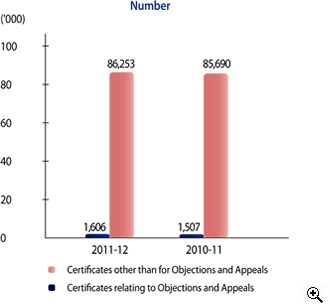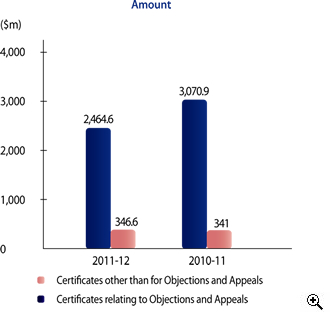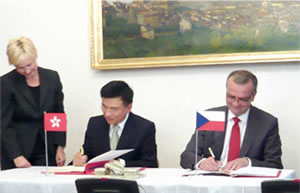Assessing Functions
The Department raises revenue through taxes, duties and fees in accordance with the relevant legislation. While the duties and fees collected in a year are based on the actual performance of the relevant activities in the year, earnings and profits tax are principally assessed by reference to the incomes / profits of the taxpayers in the previous year. For 2011-12, earnings and profits tax assessed increased by $35.9 billion (25.4%) (
Schedule 2). The total amount of duties and fees collected, however, dropped by $4.5 billion (6.8%).
Profits Tax
Profits tax is levied on individuals, corporations, bodies of persons and partnerships, in respect of assessable profits arising in or derived from Hong Kong. For the year of assessment 2011-12, the tax rates for corporations and non-corporate persons remained unchanged at 16.5% and 15% respectively.
Reflecting a full-fledged upturn in the state of the economy, profits tax assessed in 2011-12 increased to $115.8 billion, or $26.8 billion (30.1%) more than that of the previous year (Figure 5). The amounts of tax assessed in respect of different business sectors are shown in Schedules 3 and 4. Of the total tax assessed, the property and financial sectors together contributed 39.8% while the distribution sector generated 26.2% (Figure 6).
Figure 5 Profits tax assessed

Figure 6 Ratios of corporation profits tax assessed by business sectors

Salaries Tax
Salaries tax is charged on all income from any office (e.g. a directorship) or employment and pension arising in or derived from Hong Kong. The total amount of tax payable is restricted to the standard rate on the net total income (without allowances) of the individual concerned. For the year of assessment 2011-12, the standard rate remained unchanged at 15%.
As compared with the previous year, the number of assessments made increased by 1.7%, and 17.4% more tax was assessed during 2011-12 (Figure 7). Analyses of the amounts of tax assessed and allowances granted in respect of taxpayers at various income levels are provided in Schedules 5 and 6.
Figure 7 Salaries tax assessments
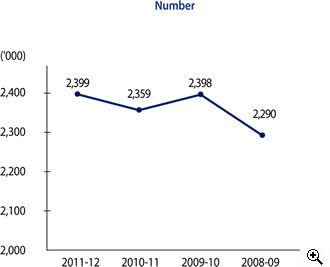

The number of standard rate taxpayers increased by 4,373 from 22,407 last year to 26,780. These taxpayers together contributed 39% of the salaries tax assessed, compared to 36% last year (Figure 8).
Figure 8 Standard rate taxpayers

Notification Requirements of Employers
Apart from reporting commencements and cessations of employments, employers are required to prepare annual employer's returns to report the emoluments of each of their employees. During the year, 277,692 employers filed employer's returns for the year of assessment 2010-11 with the Department.
The Department provides e-Seminars and disseminates tax information to employers on the IRD Homepage to help them understand the relevant statutory requirements. The contents cover completion of employer's returns, employer's obligations and answers to frequently asked questions. Employers can also obtain specimens of completed employer's returns and notification forms through the Fax-A-Form service.
Property Tax
Property owners (including corporations) are subject to property tax which is charged at the standard rate in respect of the net assessable value of the property. For the year of assessment 2011-12, the standard rate remained unchanged at 15%. Property owners that pay property tax in respect of premises used for their businesses can have such payments set off against their profits tax liabilities. For corporations, income arising from properties owned by them is also subject to profits tax at the corporation rate. To obviate the need for yearly set-off of property tax against profits tax, a corporation can apply for exemption of property tax on the property concerned.
Statistics on the classification of properties and classification by number of owners, based on the records of the Department, are provided in Schedule 7. The number of assessments made in 2011-12 was 1.6% more than that in the previous year. Reflecting a rise in rent, the total amount of property tax assessed increased by 16.5% as compared with the previous year (Figure 9).
Figure 9 Property tax assessments
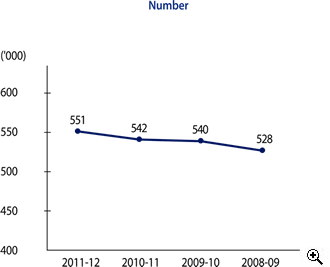

Personal Assessment
An individual may elect for personal assessment in respect of his or her total income. Under personal assessment, all the incomes of the taxpayer and his or her spouse are aggregated and, after deduction of all allowances, are assessed at the graduated tax rates. In appropriate circumstances, this would reduce the total tax liability of the taxpayer and his or her spouse.
As compared with last year, the number of assessments made in 2011-12 slightly decreased by 0.6%, but the amount of tax assessed was 17.5% higher (Figure 10).
Figure 10 Assessments made under personal assessment
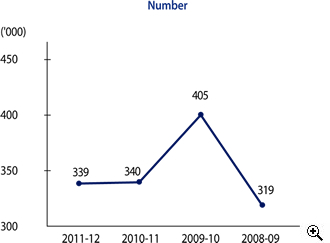
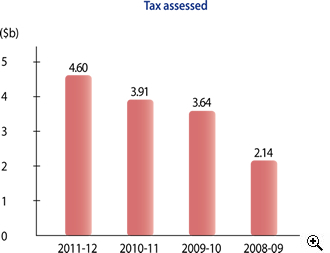
Tax Treaty Network
Double taxation arises where the same item of income or profit of a taxpayer is subject to tax in Hong Kong as well as in another tax jurisdiction. To establish a tax treaty network can help minimise exposure of Hong Kong residents and residents of the tax treaty partners to double taxation. It will also facilitate the flows of trade, investment and talent between Hong Kong and the rest of the world, and enhance Hong Kong's competitiveness as an international financial, investment and commercial hub.
As at 31 March 2012, Hong Kong has signed comprehensive double taxation agreements (covering various types of income) with 23 jurisdictions. They are Belgium, Thailand, the Mainland of China, Luxembourg, Vietnam, Brunei, the Netherlands, Indonesia, Hungary, Kuwait, Austria, the United Kingdom, Ireland, Liechtenstein, France, Japan, New Zealand, Switzerland, Portugal, Spain, the Czech Republic, Malta and Jersey.
Advance Rulings
The advance ruling service allows a person to apply for a ruling on how a provision of the Inland Revenue Ordinance applies in relation to a particular arrangement. A fee is charged for the service on a “cost recovery” basis. The applicant is required to pay an initial application fee of $30,000 for a ruling concerning the “Territorial Source Principle”, or $10,000 for a ruling on any other matter. An additional fee is payable if the processing time exceeds the specified limit. The Department endeavours to provide a ruling within 6 weeks of the date of application, provided that all relevant information is supplied with the application and further information from the applicant is not required.
During 2011-12, the Department completed the processing of 53 advance ruling applications (Figure 11). Most of the applications were for rulings on profits tax matters.
Figure 11 Advance rulings
| |
|
|
|
2011-12
Number |
|
|
|
2010-11
Number |
|
| |
Awaiting decision at the beginning of the year |
|
|
18 |
|
|
|
15 |
|
| |
| Add: |
|
Applications received during the year |
|
|
|
| 50 |
 |
|
|
|
|
| 32 |
 |
|
|
| |
|
|
|
68 |
|
|
|
47 |
|
| |
|
|
|
|
|
|
|
|
|
| |
 |
|
Rulings made |
|
35 |
|
|
|
18 |
|
|
|
| |
 |
|
Applications withdrawn |
|
14 |
|
|
|
9 |
|
|
|
| |
 |
|
Rulings declined |
|
| 4 |
 |
|
|
| 53 |
 |
|
|
| 2 |
 |
|
|
| 29 |
 |
|
|
| |
Awaiting decision at the end of the year |
|
|
|
|
|
|
|
|
Objections
A taxpayer who is aggrieved by an assessment may lodge a notice of objection to the Commissioner within the prescribed time limit. If the objection is against an estimated assessment issued because of the failure to lodge a tax return on time, a properly completed return, together with the supporting accounts where applicable, must also be submitted with the notice of objection. A significant proportion of the objections received each year arises from estimated assessments. Most of these objections are settled promptly by reference to the returns subsequently received. Many of the other types of objections are also settled by agreement between the taxpayers and the assessors concerned. Only relatively few objections are ultimately referred to the Commissioner for determination. During 2011-12, the Department settled over 70,300 objections (Figure 12).
Figure 12 Objections
| |
|
|
|
2011-12
Number |
|
|
2010-11
Number |
|
| |
Awaiting settlement at the beginning of the year |
|
|
26,689 |
|
|
25,826 |
|
| |
| Add: |
|
Received during the year |
|
|
|
| 72,662 |
 |
|
|
|
| 67,049 |
 |
|
|
| |
|
|
|
99,351 |
|
|
92,875 |
|
| |
|
|
|
|
|
|
|
|
| |
 |
|
Settled without determination |
|
|
69,637 |
|
|
65,572 |
|
|
| |
 |
|
Determinations: |
|
|
|
|
|
|
|
|
| |
 |
|
Assessments confirmed |
|
398 |
|
|
356 |
|
|
|
| |
 |
|
Assessments reduced |
|
228 |
|
|
170 |
|
|
|
| |
 |
|
Assessments increased |
|
92 |
|
|
84 |
|
|
|
| |
 |
|
Assessments annulled |
|
| 10 |
 |
|
| 728 |
 |
|
| 70,365 |
 |
|
| 4 |
 |
|
| 614 |
 |
|
| 66,186 |
 |
|
|
| |
Awaiting settlement at the end of the year |
|
|
|
|
|
|
|
Appeals to the Board of Review
A taxpayer who is dissatisfied with the Commissioner's determination of his objection may appeal to the Board of Review (Inland Revenue Ordinance) (the Board). The Board is an independent statutory body. As at 31 March 2012, the Board consisted of a chairman and 6 deputy chairmen, who have legal training and experience, as well as 73 other members. During 2011-12, the Board settled 74 appeal cases (Figure 13).
Figure 13 Appeals to the Board of Review
| |
|
|
|
|
|
Number |
|
| |
Awaiting hearing or decision as at 1 April 2011 |
|
|
|
|
66 |
|
| |
| Add: |
|
Received during the year |
|
|
|
|
|
| 90 |
 |
|
|
| |
|
|
|
|
|
156 |
|
| |
|
|
|
|
|
|
|
| |
 |
|
Withdrawn |
|
|
|
21 |
|
|
|
| |
 |
|
Decided: |
|
|
|
|
|
|
|
| |
 |
|
Assessments confirmed |
|
39 |
|
|
|
|
|
| |
 |
|
Assessments reduced in full |
|
4 |
|
|
|
|
|
| |
 |
|
Assessments reduced in part |
|
3 |
|
|
|
|
|
| |
 |
|
Assessments increased |
|
7 |
|
|
|
|
|
| |
 |
|
Assessments annulled |
|
0 |
|
|
|
|
|
| |
 |
|
Others |
|
| 0 |
 |
|
|
| 53 |
 |
|
|
| 74 |
 |
|
|
| |
Awaiting hearing or decision as at 31 March 2012 |
|
|
|
|
|
|
Appeals to the Courts
A decision of the Board is final, provided that either the taxpayer or the Commissioner may, pursuant to section 69(1) of the Inland Revenue Ordinance, make an application requiring the Board to state a case on a question of law for the opinion of the Court of First Instance. Apart from appealing to the Board and then further appealing to the Court of First Instance by way of case stated, where both parties agree, an appeal can be transmitted to the Court of First Instance direct under section 67 of the Inland Revenue Ordinance without a hearing before the Board.
During 2011-12, the Court of First Instance ruled on three cases relating to the Inland Revenue Ordinance. One case was concerned with two issues, namely whether the profits derived from provision of sourcing and agency services were offshore and whether deduction of a marketing commission was caught by the anti-avoidance provisions. The Court of First Instance found in favour of the taxpayer on the first issue and remitted the second issue to the Board. The second issue remained unsettled as at 31 March 2012. The issues involved in the other two cases were the taxability of unrealized gains arising from revaluation of trading investments and the taxability of a lump sum received by a taxpayer pursuant to the franchise agreement respectively. The Court of First Instance allowed the taxpayers' appeals in both cases.
The Commissioner appealed to the Court of Appeal against the judgments of the Court of First Instance for the above three cases. The Court of Appeal has heard the appeal concerning the source issue and dismissed the Commissioner's appeal.
Under section 69A of the Inland Revenue Ordinance, an appellant or the Commissioner may, with the leave of the Court of Appeal, appeal against the decision of the Board directly to the Court of Appeal instead of the Court of First Instance. During the year, there was an appeal lodged directly to the Court of Appeal pursuant to section 69A of the Inland Revenue Ordinance.
Figure 14 sets out the statistics concerning appeals to the Courts during 2011-12.
Figure 14 Appeals to the Courts
| |
|
|
Court of
First Instance |
Court of
Appeal |
Court of
Final Appeal |
Total |
|
| |
Awaiting hearing or decision as at 1 April 2011
|
|
8 |
|
|
3 |
|
|
0 |
|
|
11 |
|
| |
Add: |
Lodged during the year |
|
| 0 |
 |
|
|
|
| 4 |
 |
|
|
|
| 0 |
 |
|
|
|
| 4 |
 |
|
|
| |
|
|
|
8 |
|
|
7 |
|
|
0 |
|
|
15 |
|
| |
Less: |
Disposed of - |
|
|
|
|
|
|
|
|
|
|
|
|
| |
|
Decided |
2 |
|
|
1 |
|
|
0 |
|
|
3 |
|
|
| |
|
Partly heard and decided (Note) |
1 |
|
|
0 |
|
|
0 |
|
|
1 |
|
|
| |
|
Discontinued |
| 1 |
 |
|
| 4 |
 |
|
|
| 1 |
 |
|
| 2 |
 |
|
|
| 0 |
 |
|
| 0 |
 |
|
|
| 2 |
 |
|
| 6 |
 |
|
|
| |
|
|
|
4 |
|
|
5 |
|
|
0 |
|
|
9 |
|
| |
Add: |
Partly heard and decided (Note) |
|
| 1 |
 |
|
|
|
| 0 |
 |
|
|
|
| 0 |
 |
|
|
|
| 1 |
 |
|
|
| |
Awaiting hearing or decision as at 31 March 2012 |
|
|
|
|
|
|
|
|
|
|
|
|
| |
|
|
|
|
|
|
|
|
|
|
|
|
|
|
| Note: |
This refers to a case that involved two issues but only one of them was ruled by the Court of First Instance during 2011-12 whilst the other issue remained unsettled as at 31 March 2012. |
Business Registration
The Department aims to maintain an efficient business registration system. A person carrying on a business in Hong Kong must register the business and pay the required fee and levy. Business registration certificates are valid for one year unless 3-year certificates have been elected. As at 31 March 2012, 15,149 businesses had taken 3-year certificates.
The number of business registrations as at 31 March 2012 stood at 1,134,032, which was 73,836 more than that as at 31 March 2011 and was an all time high (Figure 15). There was also a corresponding increase in the number of certificates issued. Comparing to the previous year, the total number of new registrations and re-opened registrations in 2011-12 was 23,747 lesser while the number of cancelled registrations was 17,479 more (Schedule 8).
Figure 15 Number of business registrations

By virtue of the Revenue (Reduction of Business Registration Fees) Order 2010, the annual fees in respect of business and branch registration certificates with commencement dates falling within the period from 1 August 2010 to 31 July 2011 (“Waiver Period”) are waived. Businesses issued with 1-year certificates commencing during the Waiver Period only need to pay the levy for the Protection of Wages on Insolvency Fund of $450, and businesses electing for 3-year certificates are required to pay $3,200 for the business registration fee and $1,350 for the levy.
Businesses that are not required to renew their registration certificates in the Waiver Period can apply for concessionary refunds if they have paid the registration fees for the Waiver Period (i.e. businesses holding 3-year certificates with expiry dates falling on or after 31 July 2011; or between 1 August 2010 and 31 July 2011 but are not required to renew their registration certificates because of cessation of business). Up to 31 March 2012, the Department had issued concessionary refunds to 7,734 businesses totalling $9.9 million.
As the Waiver Period ended on 31 July 2011, business registration fees are payable for certificates commencing during the period from 1 August 2011 to 31 March 2012. The business registration fees collected in 2011-12 amounted to $1,292.9 million, representing a drastic increase of 35 times compared to last year (Figure 16).
Figure 16 Certificates issued and fees collected
| |
|
2011-12 |
|
2010-11 |
|
Increase |
|
| |
Number of certificates issued (Main and Branch) |
1,158,838 |
|
1,125,127 |
|
+3% |
|
| |
Fees (inclusive of penalties) ($m) |
1,292.9 |
|
35.8 |
|
+3,511% |
|
Under the Business Registration Ordinance, a small business with average monthly sales or receipts below a specified limit ($10,000 for a business mainly deriving profits from the sale of services, or $30,000 for other businesses) can apply for exemption from payment of the business registration fee and levy. The number of exemptions granted during 2011-12 was 13,697, representing an increase of 15.7% from the previous year.
Where an application for exemption is not allowed, the business operator may appeal to the Administrative Appeals Board. Two appeals had been received by the Board in 2011-12, but both were withdrawn by the appellants subsequently (Figure 17).
Figure 17 Appeals to the Administrative Appeals Board
| |
|
|
|
2011-12
Number |
|
|
|
2010-11
Number |
|
| |
Awaiting hearing at the beginning of the year |
|
|
0 |
|
|
|
0 |
|
| |
| Add: |
|
Lodged during the year |
|
|
|
| 2 |
 |
|
|
|
|
| 0 |
 |
|
|
| |
|
|
|
2 |
|
|
|
0 |
|
| |
|
|
|
|
|
|
|
|
|
| |
 |
|
Appeal allowed |
|
0 |
|
|
|
0 |
|
|
|
| |
 |
|
Appeal dismissed |
|
0 |
|
|
|
0 |
|
|
|
| |
 |
|
Appeal withdrawn |
|
| 2 |
 |
|
|
| 2 |
 |
|
|
| 0 |
 |
|
|
| 0 |
 |
|
|
| |
Awaiting hearing at the end of the year |
|
|
|
|
|
|
|
|
Stamp Duty
Stamp duty is charged on instruments effecting property transactions, stock transactions and leasing of property in Hong Kong (Figure 18).
Due to the deterioration of the global economy and the anti-speculative measures in respect of residential properties adopted by the Government, the property market had slowed down significantly since mid-2011. As a result, the stamp duty collections from property transactions in 2011-12 decreased by 17% to $20.4 billion. The stamp duty collections from leases and other documents also slightly dropped by 4% to $602 million.
Amid the bleak global economic outlook, the stock market had also indicated a downturn trend since September 2011. The stamp duty collections from share transactions in 2011-12 recorded $23.3 billion, a decrease of 10% from the previous year.
Overall, there was a decrease of 13% in the total stamp duty collected during the year and the number of documents stamped also decreased by 13% (Figure 19 and Schedule 9).
Figure 18 Composition of stamp duty collections

Figure 19 Stamp duty collections
| |
|
2011-12
($m) |
|
2010-11
($m) |
|
Decrease |
|
| |
Immovable Properties |
20,448 |
|
24,504 |
|
-17% |
|
| |
Shares |
23,306 |
|
25,877 |
|
-10% |
|
| |
Leases and other documents |
602 |
|
624 |
|
-4% |
|
| |
Total |
44,356 |
|
51,005 |
|
-13% |
|
Estate Duty
Estate duty is charged on that part of a deceased person's estate situated in Hong Kong. The threshold for levying duty is $7.5 million and the duty rates range from 5% to 15%, depending on the value of the estate.
The Revenue (Abolition of Estate Duty) Ordinance 2005 came into effect on 11 February 2006 abolishing estate duty in respect of persons passing away on or after that date. No estate duty affidavits and accounts need to be filed and no estate duty clearance papers are needed for the application for a grant of representation in respect of deaths occurring on or after that date. The estate duty chargeable in respect of estates of persons dying between the period 15 July 2005 to 10 February 2006, with the principal value exceeding $7.5 million, is reduced to a nominal amount of $100. With the abolition of estate duty, the number of new cases reduced gradually to 1,301 in 2011-12, a drop of 16.8% from the last year (Figure 21).
Figures 20 and 21 show the composition of estates and cases processed for the past two years.
Figure 20 Composition of estates

Figure 21 Estate duty cases
| |
|
2011-12
Number |
|
2010-11
Number |
|
| |
New cases |
|
|
|
|
| |
Cases finalised |
|
|
|
|
| |
 |
|
- Dutiable |
|
35 |
|
66 |
|
| |
 |
|
- Exempt |
|
| 1,293 |
 |
|
|
| 1,538 |
 |
|
|
| |
|
|
|
|
|
Estate duty of $94 million was collected during the year (
Schedule 10), a decrease of $119 million (56%) compared with the previous year.
Estate duty is payable on delivery of an estate duty affidavit or account (or within 6 months from the date of the deceased's death, whichever is the earlier). $38 million was received during the year in advance of the issue of formal assessments
(
Schedule 10).
Betting Duty
Betting duty is charged on the net stake receipts from betting on horse races and football matches and on the proceeds of Mark Six lotteries, all administered by the Hong Kong Jockey Club. In 2011-12, the rates of betting duty on these betting activities remained unchanged (Figure 22).
Figure 22 Rates of betting duty in 2011-12
| |
|
|
|
Rate |
|
|
| |
Horse racing |
Net stake receipts |
|
|
|
|
| |
|
|
|
72.5% |
* |
|
| |
|
|
|
73% |
|
|
| |
|
|
|
73.5% |
|
|
| |
|
|
|
74% |
|
|
| |
|
|
|
74.5% |
|
|
| |
|
|
|
75% |
|
|
| |
Mark Six lotteries |
Proceeds |
|
25% |
|
|
| |
Football betting |
Net stake receipts |
|
50% |
|
|
| Note: * |
For overseas bets, the discount rate for specified places (e.g. Macau) is 40%, whereas the discount rate for a place outside Hong Kong (other
than specified places) is 50%. |
In 2011-12, betting duty collections from horse racing, Mark Six lotteries and football betting increased by 5.1%, 25.5% and 2.9% respectively (Schedule 11). The total betting duty collected in 2011-12 was 6.8% higher than the previous year (Figure 23).
Figure 23 Betting duty collections
| |
|
2011-12
($m) |
|
2010-11
($m) |
|
Increase |
|
| |
Horse racing |
10,002.4 |
|
9,516.0 |
|
+5.1% |
|
| |
Mark Six lotteries |
2,013.6 |
|
1,604.1 |
|
+25.5% |
|
| |
Football betting |
3,744.6 |
|
3,638.9 |
|
+2.9% |
|
| |
Total |
15,760.6 |
|
14,759.0 |
|
+6.8% |
|
Tax Reserve Certificates
Taxpayers may purchase Tax Reserve Certificates (TRCs) under two situations.
The first situation applies to taxpayers who wish to save for the payment of their future tax liabilities. IRD has set up two schemes, namely the “Electronic Tax Reserve Certificates Scheme” for all taxpayers and the “Save-As-You-Earn” (SAYE) Scheme for civil servants and civil service pensioners. With a Tax Reserve Certificate account, taxpayers may purchase TRCs by various channels, including bank auto-pay, telephone, the Internet and bank ATM. Under the “SAYE Scheme”, civil servants and civil service pensioners can purchase TRCs through monthly deductions from their salaries / pensions. Interest is payable on the TRCs when they are redeemed for settlement of tax liabilities, based on the interest rate prevailing at the time of purchase, for a maximum period of 36 months from the date of purchase.
Compared with last year, there was an increase of 4.3% and 2.4% respectively in the number and the amount of TRCs sold under the “Electronic Tax Reserve Certificates Scheme” but a decrease of 2.4% and 1% respectively for the “SAYE Scheme” in
2011-12 (Schedule 12). Overall, the total amount of TRCs sold increased by 1.6% (Figure 24).
The second situation applies to taxpayers who object to tax assessments and are required to purchase TRCs in respect of the tax in dispute. Such TRCs are used to settle any tax found payable upon the finalisation of the objection or appeal. Interest is only payable on the amount of the TRC, if any, subsequently required to be repaid to the taxpayer, and is computed at floating rates over the tenure of the TRC.
Figure 24 Certificates sold
